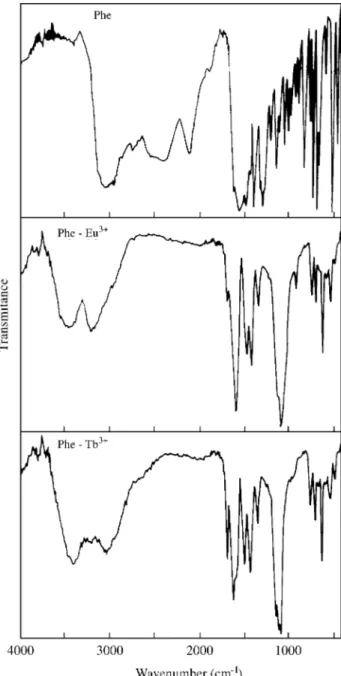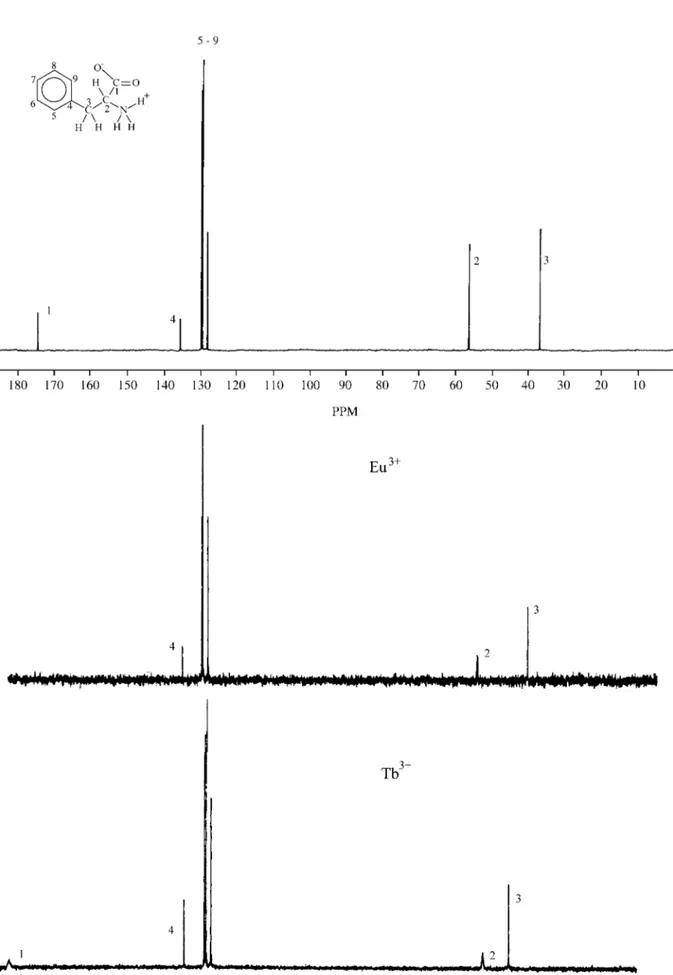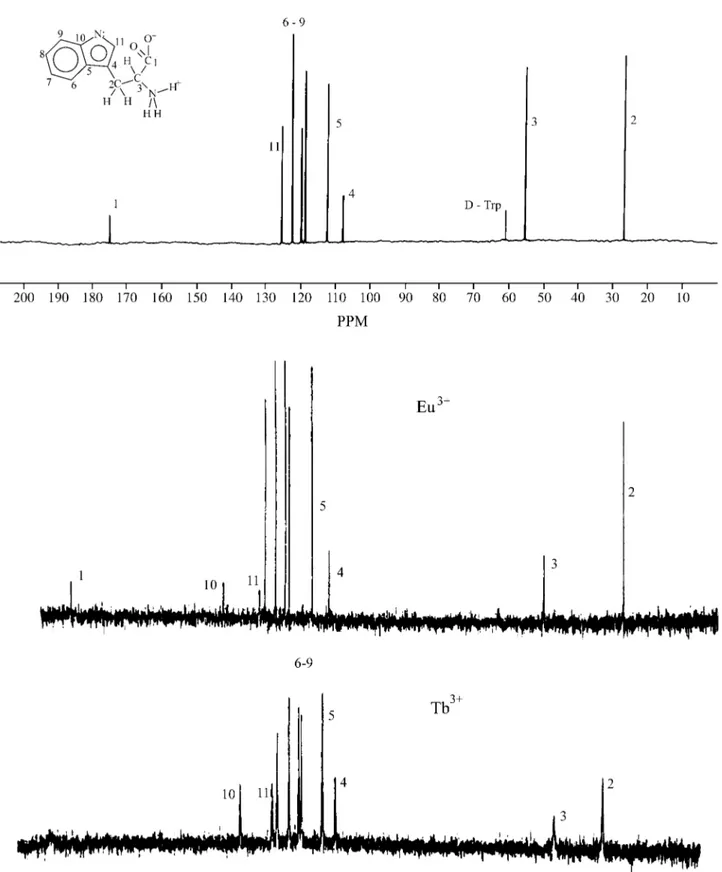Study of the Binding of Eu
3+and Tb
3+to
L-phenylalanine and L-tryptophan
Célia R. Carubelli, Ana M. G. Massabni, and Sergio R. de A. Leite*
Instituto de Química, Universidade Estadual Paulista, C.P. 355, 14801-970 Araraquara - SP, Brazil
Received: August 23, 1996
Os íons európio e térbio trivalentes possuem raios iônicos semelhantes àquele do Ca2+. Em função disto, eles são usados como sondas de sítios de ligação de cálcio em moléculas de seres vivos. Tais íons possuem características espectroscópicas muito úteis ao seu estudo, particularmente uma luminescência intensa. Em proteínas contendo estes íons lantanídios a elas ligados, emissão de luz pode ser observada quando radiação no UV é absorvida por seus resíduos de aminoácidos aromáti-cos, indicando que há transferência de energia para o íon lantanídio. O presente trabalho foi feito com o objetivo de definir os sítios de ligação do Eu3+ e do Tb3+ nos complexos com os aminoácidos aromáticos L-fenilalanina e L-triptofano. As técnicas utilizadas foram as espectroscopias no infravermelho e de ressonância magnética nuclear de 13C. Foi verificado que európio e térbio trivalentes interagem com o grupo carboxilato de ambos os aminoácidos. Com o L-triptofano o grupo imino do anel indólico também se liga ao lantanídio, representando um segundo ponto de coordenação.
Trivalent europium and terbium ions have ionic radii similar to that of Ca2+. So they are employed as probes of calcium binding sites in biological molecules. These ions exhibit very useful spectroscopic characteristics, chiefly a pronounced luminescence. In protein bound lanthanide, visible light emission from the lanthanide excited states can be observed when UV light is absorbed by aromatic amino acids. Subsequently, the energy is transferred to the lanthanide ion. The present work was carried out to define the binding sites of Eu3+ and Tb3+ in complexes with the aromatic amino acids L-phenylalanine and L-tryptophan. The techniques utilized were infrared and 13C nuclear magnetic resonance spectroscopies. It was found that trivalent europium and terbium interact with the carboxylate group of both amino acids. With L-tryptophan, the imino group of the indole ring is also involved representing another coordination site.
Keywords:aromatic amino acids, lanthanides
Introduction
About a third of all proteins in their native state contain bound metal ions, or require metal ions for a variety of metabolic pathways1. In many cases, Ca2+ either constitutes protein metal center or is needed for cell biological activity. This metal ion exhibits no satisfactory spectroscopic prop-erties, so the study of calcium depending proteins by spec-troscopic techniques is extremely difficult. To overcome this problem, it is often possible to substitute a trivalent lanthanide (Ln3+) for Ca2+ ions within those proteins. No serious structural changes or loss of specific functions are observed after such substitution. Among the lanthanide
ions, Tb3+ and Eu3+ generally show luminescent emission that is enhanced when these ions are bound to a protein. The luminescence excitation may be performed by irradia-tion in the range of aromatic spectral absorpirradia-tion bands. As a rule, tryptophan is responsible for energy transfer to Ln3+ ions, although tyrosine and phenylalanine may be involved in this process2.
So, it seems profitable, in view of eventual biochemical and biophysical applications, to study the interaction be-tween aromatic amino acids and lanthanide ions, whose luminescence may be considered as specific to prove their presence. No paper has been published on this issue in Article
recent years. The last work published is that by Aizawa et al., in 1987, where the interaction of tryphophan with Tb3+ ions had been studied using fluorescence and 1H-NMR spectroscopies3. These authors had concluded that terbium interacts with α-amino and imine groups, the latter belong-ing to the indole rbelong-ing. No interaction with the carboxylate group was reported. Such conclusions, based mainly on the 1H-NMR measurements, seem unconvincing, since they are in contradiction with the coordination chemistry of the lanthanides. These hard acids according to Pearson’s the-ory4, should interact more strongly with oxygen than with nitrogen. Especially when the latter has a positive charge, this being the case of the α-amino group in the zwitterion form of the amino acid. In aqueous solution even a neutral amine cannot compete with water molecules for Ln3+ co-ordination5.
This disagreement has been the reason to re-open the issue, resulting in the present work. Herein, we describe the interac-tion of Eu3+ and Tb3+ with the aromatic amino acids L-tryp-tophan and L-phenylalanine, by nuclear magnetic resonance with 13C-NMR and infrared spectroscopies.
Experimental
Infrared spectra were obtained using a Nicolet 730 FT-IR spectrometer, using the samples in the form of KBr pellets. A Bruker AC200 spectrometer was utilized for recording the 13C-NMR spectra (field of 4.7 T and fre-quence of 50 MHz), the samples were dissolved in D2O.
The coordination compounds of lanthanides (Eu3+ and Tb3+) and the ligands (L-phenylalanine and L-tryptophan) were obtained by reaction of the lanthanide perchlorates with the corresponding amino acids, in 1:1 water-ethanol mixtures. These were concentrated by solvent evaporation and the water content reduced by successive additions of absolute ethanol, until the remaining water was minimal. After that, some drops of benzene were added to them, and the solutions were placed into a refrigerator and left there for some days until precipitation started. After completed the precipitation, the solutions were filtered, and the solid residue washed with absolute ethanol and dried under vacuum. The stoichiometry of the complex compounds was confirmed by CHN elemental analysis, while the metal content was determined by complexometric titrations with EDTA. The lanthanide perchlorates were prepared heating the lanthanide oxides with 1.0 M perchloric acid solution, in stoichiometric quantities.
All the reagents utilized were of analytical grade, the L-amino acids were supplied by Sigma and the lanthanides oxides from Aldrich.
Results and Discussion
The elemental analyses (Table 1) were compatible with the following compound formulae: Tb(L-phe)3(ClO4)3.
2H2O; Eu(L-phe)3(ClO4)3.4H2O; Tb(L-trp)3(ClO4)3.H2O and Eu(L-trp)3(ClO4)3.4H2O. The infrared spectra of the compounds (Figs. 1 and 2) have shown changes in the position and profiles of some bands, as compared to that of the free amino acids, suggesting the participation of the groups that produce these bands in the coordination bon with the lanthanides. Major changes, in all IR patterns, are related to the carboxylate bands. In the case of L-pheny-lalanine (Fig. 1), the bands at 1410 cm-1 and 1565 cm-1, corresponding to the carboxylate symmetrical and asym-metrical stretchings, respectively, are shifted to higher wavenumbers after complexation with Tb3+ and Eu3+ . Thus indicating coordination through that group. The remaining
carboxylate bands, namely γCOO-, ωCOO- and ρCOO-, formerly at 780, 681 and 526 cm-1, respectively, also showed changes as a result of the coordination process.
L-tryptophan (Fig. 2) behaved similarly with respect to the carboxylate bands: the asymmetric stretch at 1592 cm-1, the symmetric stretch at 1413 cm-1 and the deformation vibra-tions in the region between 700 and 520 cm-1. The former, stretching vibration, was displaced to 1619 and 1623 cm-1 (compounds with Eu3+ and Tb3+ respectively) and the latter to 1425 and 1429 cm-1, with respect to Eu+3 and Tb+3. The indolic nitrogen contributes to the bands at 1413 and 533 cm-1 , and their displacement after the coordination suggests that this group is a second binding center for the lanthanide ions.
The 13C-NMR spectrum of L-phenylalanine (Fig. 3) shows no carboxylate carbon signal at 174.3 ppm after the complexation with Eu3+, and it was shifted to lower field (197.1 ppm) in the Tb3+ compound. The signal of the carboxylate neighbouring carbon was shifted to higher field in both complexes. These results are compatible with the lanthanide complexation by the carboxylate, since it causes a decrease of the electron density around the corre-sponding carbon atom with its consequent striping in rela-tion to the magnetic field. On the contrary, the neighbouring carbon enriches its electron density and this increase in shielding displaces the NMR signal toward a higher field.
The L-tryptophan 13C-NMR spectrum (Fig. 4) shows a similar behaviour of the C-carboxylate and α-C resonance peaks after complexation with Eu3+and Tb3+: the shift of the former to lower fields and of the latter to higher fields. The interpretation is the same, thus indicating that carboxy-late is a coordination site. The most interesting feature of the spectra of the coordination compounds with tryptophan is the appearence of two additional signals, at 136 and 128 ppm. These peaks may be associated with quaternary like carbon atoms, located close to the indole nitrogen. These signals are absent in the spectrum of free L-tryptophan and their presence in the lanthanide complexes also suggests coordination by the nitrogen atom of the indole group. The nitrogen interaction with the lanthanide ion shortens the nuclear spin relaxation time of the two neighbouring car-bons, resulting in the appearence of the above signals.
Table 1. Elemental analysis results.
Compound % Metal % C % H % N
E* C# E C E C E C
Eu(L-phe)3(ClO4). 4H2O 16,20 16,07 31,13 31,80 4,04 4,02 4,17 4,12
Tb(L-phe)3(ClO4)3.2H2O 16,72 16,68 32,54 32,80 4,07 3,46 4,51 4,25
Eu(L-trp)3(ClO4)3.4H2O 14,64 14,29 36,31 37,25 5,43 5,08 7,58 7,90
Tb(L-trp)3(ClO4)3.H2O 14,54 14,85 36,51 36,42 3,94 3,49 7,74 7,72
* Experimental value.
# Calculated from formula.
In conclusion, the IR and 13C-NMR results suggest that the interactions between Tb3+ and Eu3+ and the ligand L-phenylalanine are due to an arrangement via the carboxylate group, while in the case of L-tryptophan both the carboxylate and the nitrogen of the indole group are involved. The pro-tonated amine group does not participate in the coordination, as would be suggested by lanthanide chemistry and by the presence of a strong positive charge on this group.
Acknowledgments
Supported in part by CAPES, Brazil.
References
1. Horrocks Jr., W. DeW.; Sudnick, D.R. Acc. Chem. Res. 1981, 14, 384.
2. Brittain, H.G.; Richardson, F.S.; Martin, R.B. J. Am. Chem. Soc.1976,98, 8255.
3. Aizawa, K.; Ohhata, S.; Nishie, H.; Ohsaka, A.; Kato, K.; Matsushita, K.; Hioka, K.; Biochem. Bioph. Res. Commun. 1987, 146, 791.
4. Pearson, R.G. J. Am. Chem. Soc. 1963, 85, 3533. 5. Richardson, F.S. Chem. Rev. 1982, 82, 541.



